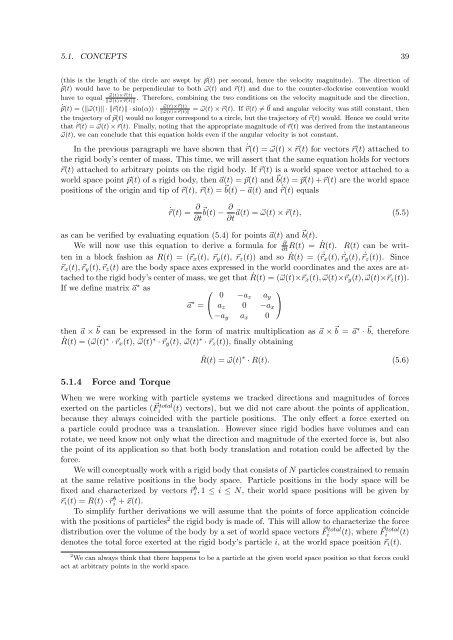thesis - Computer Graphics Group - Charles University - Univerzita ...
thesis - Computer Graphics Group - Charles University - Univerzita ...
thesis - Computer Graphics Group - Charles University - Univerzita ...
Create successful ePaper yourself
Turn your PDF publications into a flip-book with our unique Google optimized e-Paper software.
5.1. CONCEPTS 39<br />
(this is the length of the circle arc swept by p(t) per second, hence the velocity magnitude). The direction of<br />
˙p(t) would have to be perpendicular to both ω(t) and r(t) and due to the counter-clockwise convention would<br />
have to equal<br />
ω(t)×r(t)<br />
. Therefore, combining the two conditions on the velocity magnitude and the direction,<br />
ω(t)×r(t)<br />
˙p(t) = (ω(t) · r(t) · sin(α)) · ω(t)×r(t)<br />
ω(t)×r(t) = ω(t) × r(t). If v(t) = 0 and angular velocity was still constant, then<br />
the trajectory of p(t) would no longer correspond to a circle, but the trajectory of r(t) would. Hence we could write<br />
that ˙ r(t) = ω(t) × r(t). Finally, noting that the appropriate magnitude of r(t) was derived from the instantaneous<br />
ω(t), we can conclude that this equation holds even if the angular velocity is not constant.<br />
In the previous paragraph we have shown that ˙ r(t) = ω(t) × r(t) for vectors r(t) attached to<br />
the rigid body’s center of mass. This time, we will assert that the same equation holds for vectors<br />
r(t) attached to arbitrary points on the rigid body. If r(t) is a world space vector attached to a<br />
world space point p(t) of a rigid body, then a(t) = p(t) and b(t) = p(t) + r(t) are the world space<br />
positions of the origin and tip of r(t), r(t) = b(t) − a(t) and ˙ r(t) equals<br />
˙r(t) = ∂<br />
∂t b(t) − ∂<br />
a(t) = ω(t) × r(t), (5.5)<br />
∂t<br />
as can be verified by evaluating equation (5.4) for points a(t) and b(t).<br />
We will now use this equation to derive a formula for ∂<br />
∂t R(t) = ˙ R(t). R(t) can be writ-<br />
ten in a block fashion as R(t) = (rx(t), ry(t), rz(t)) and so ˙ R(t) = ( ˙ rx(t), ˙ ry(t), ˙ rz(t)). Since<br />
rx(t), ry(t), rz(t) are the body space axes expressed in the world coordinates and the axes are attached<br />
to the rigid body’s center of mass, we get that ˙ R(t) = (ω(t)×rx(t), ω(t)×ry(t), ω(t)×rz(t)).<br />
If we define matrix a ∗ as<br />
a ∗ ⎛<br />
⎞<br />
0 −az ay<br />
= ⎝ az 0 −ax ⎠<br />
−ay ax 0<br />
then a × b can be expressed in the form of matrix multiplication as a × b = a ∗ · b, therefore<br />
˙R(t) = (ω(t) ∗ · rx(t), ω(t) ∗ · ry(t), ω(t) ∗ · rz(t)), finally obtaining<br />
5.1.4 Force and Torque<br />
˙R(t) = ω(t) ∗ · R(t). (5.6)<br />
When we were working with particle systems we tracked directions and magnitudes of forces<br />
exerted on the particles ( F total<br />
i (t) vectors), but we did not care about the points of application,<br />
because they always coincided with the particle positions. The only effect a force exerted on<br />
a particle could produce was a translation. However since rigid bodies have volumes and can<br />
rotate, we need know not only what the direction and magnitude of the exerted force is, but also<br />
the point of its application so that both body translation and rotation could be affected by the<br />
force.<br />
We will conceptually work with a rigid body that consists of N particles constrained to remain<br />
at the same relative positions in the body space. Particle positions in the body space will be<br />
fixed and characterized by vectors r b i , 1 ≤ i ≤ N, their world space positions will be given by<br />
ri(t) = R(t) · r b i + x(t).<br />
To simplify further derivations we will assume that the points of force application coincide<br />
with the positions of particles2 the rigid body is made of. This will allow to characterize the force<br />
distribution over the volume of the body by a set of world space vectors F total<br />
i (t), where F total<br />
i (t)<br />
denotes the total force exerted at the rigid body’s particle i, at the world space position ri(t).<br />
2 We can always think that there happens to be a particle at the given world space position so that forces could<br />
act at arbitrary points in the world space.
















